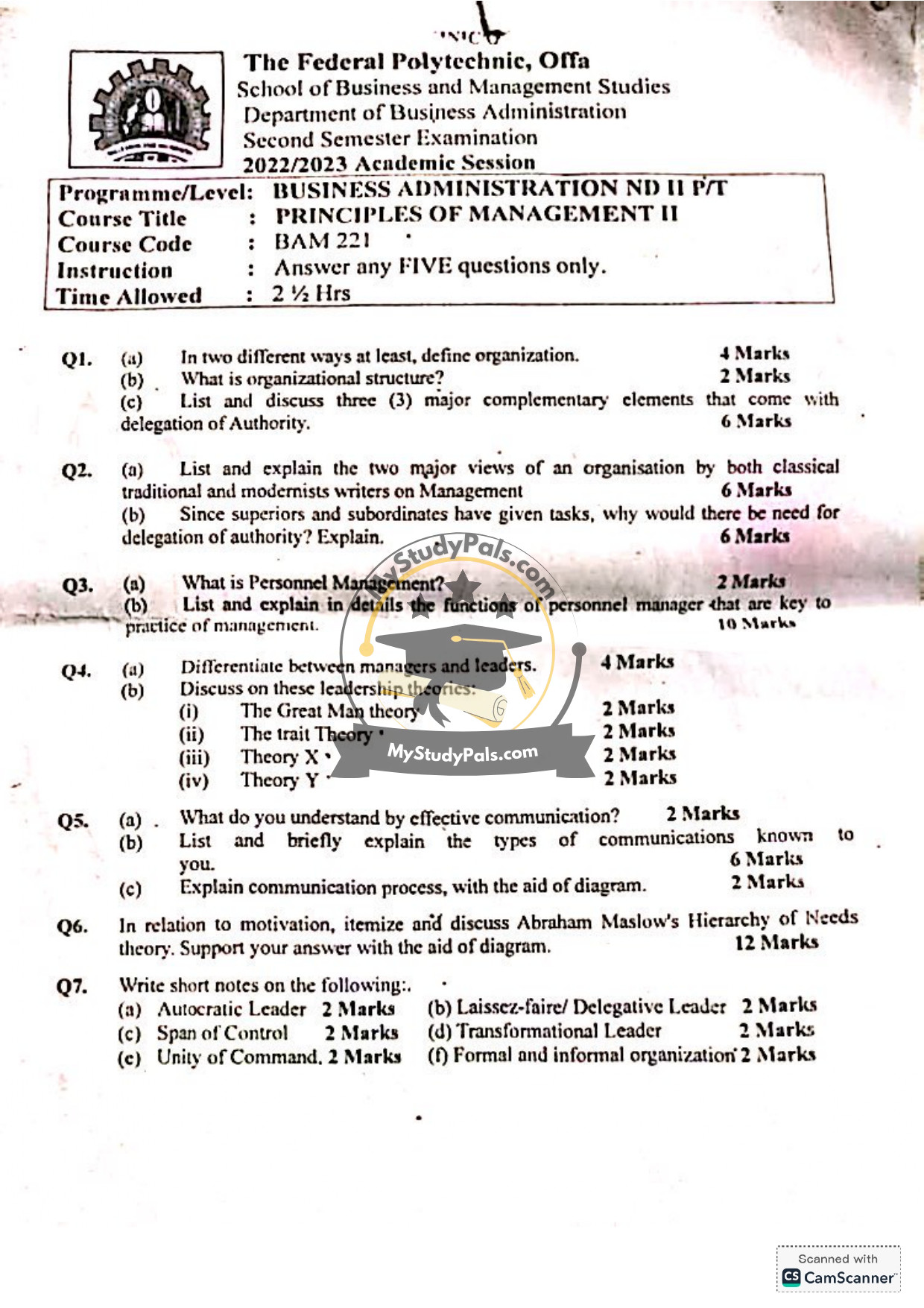ANWSER
—
### Question 1:
(a) Define organization in two different ways:
1. An organization is a structured group of people working together to achieve common goals through coordinated activities and division of labor.
2. An organization is a system of consciously coordinated activities of two or more persons, characterized by formal roles, rules, and objectives.
(b) What is organizational structure?
Organizational structure refers to the framework that outlines how activities such as task allocation, coordination, and supervision are directed toward achieving organizational goals. It defines roles, responsibilities, and reporting relationships within the organization.
(c) Three major complementary elements of delegation of authority:
1. Responsibility – The obligation of a subordinate to perform assigned duties.
2. Authority – The right or power granted to a subordinate to make decisions and carry out tasks.
3. Accountability – The requirement for the subordinate to report outcomes and justify actions to the superior.
—
### Question 2:
(a) Two major views of an organization:
1. Classical/Traditional View – Organizations are seen as rigid, hierarchical structures with clear division of labor, formal rules, and centralized authority (e.g., Max Weber’s Bureaucracy).
2. Modernist View – Organizations are dynamic systems that adapt to environmental changes, emphasizing flexibility, employee participation, and decentralized decision-making.
(b) Need for delegation of authority:
Delegation is necessary because:
– It reduces the workload of superiors, allowing them to focus on strategic tasks.
– It empowers subordinates, enhancing motivation and skill development.
– It improves efficiency by enabling faster decision-making at operational levels.
—
### Question 3:
(a) Personnel Management:
Personnel Management is the administrative function concerned with recruiting, training, compensating, and maintaining employees to achieve organizational objectives.
(b) Functions of a personnel manager:
1. Recruitment & Selection – Hiring the right talent for the organization.
2. Training & Development – Enhancing employee skills and knowledge.
3. Performance Appraisal – Evaluating employee performance for growth and rewards.
4. Compensation & Benefits – Designing fair pay structures and incentives.
5. Employee Relations – Maintaining a positive work environment and resolving conflicts.
—
### Question 4:
(a) Difference between managers and leaders:
– Managers focus on stability, processes, and efficiency, using formal authority.
– Leaders inspire, innovate, and drive change, influencing others through vision and charisma.
(b) Leadership theories:
(i) Great Man Theory – Leaders are born with innate qualities (e.g., courage, charisma).
(ii) Trait Theory – Leadership depends on specific personality traits (e.g., confidence, intelligence).
(iii) Theory X – Assumes employees dislike work and need strict supervision.
(iv) Theory Y – Assumes employees are self-motivated and seek responsibility.
—
### Question 5:
(a) Effective communication:
Effective communication is the clear and accurate exchange of information between sender and receiver, ensuring mutual understanding.
(b) Types of communication:
1. Verbal – Spoken or written words.
2. Non-verbal – Body language, gestures, facial expressions.
3. Formal – Official, structured communication (e.g., reports).
4. Informal – Casual, unofficial exchanges (e.g., gossip).
(c) Communication process (diagram explanation):
Sender → Encoding → Message → Channel → Decoding → Receiver → Feedback.
—
### Question 6:
Maslow’s Hierarchy of Needs (with diagram explanation):
1. Physiological Needs – Basic survival (food, water).
2. Safety Needs – Security, stability.
3. Social Needs – Belonging, love.
4. Esteem Needs – Respect, recognition.
5. Self-Actualization – Fulfilling potential.
*(Diagram: Pyramid with needs in ascending order.)*
—
### Question 7:
(a) Autocratic Leader – Makes decisions unilaterally with no employee input.
(b) Laissez-faire Leader – Delegates authority, allowing employees freedom.
(c) Span of Control – Number of subordinates a manager can effectively supervise.
(d) Transformational Leader – Inspires change through vision and passion.
(e) Unity of Command – Each employee reports to only one supervisor.
(f) Formal & Informal Organization – Formal: Official structure; Informal: Unofficial social networks.


